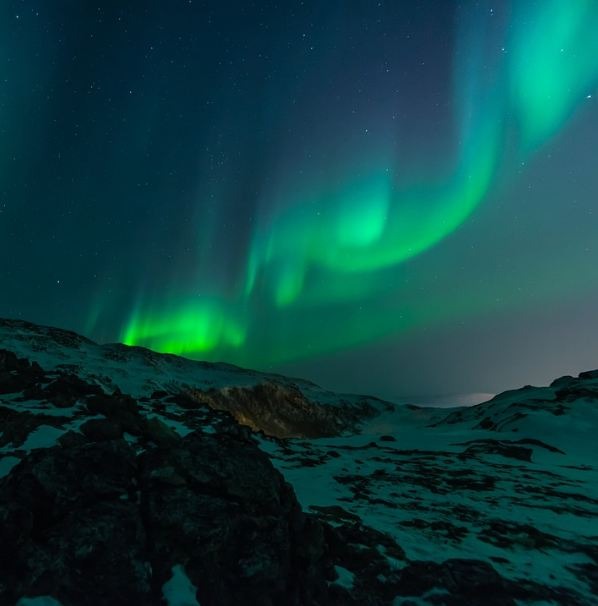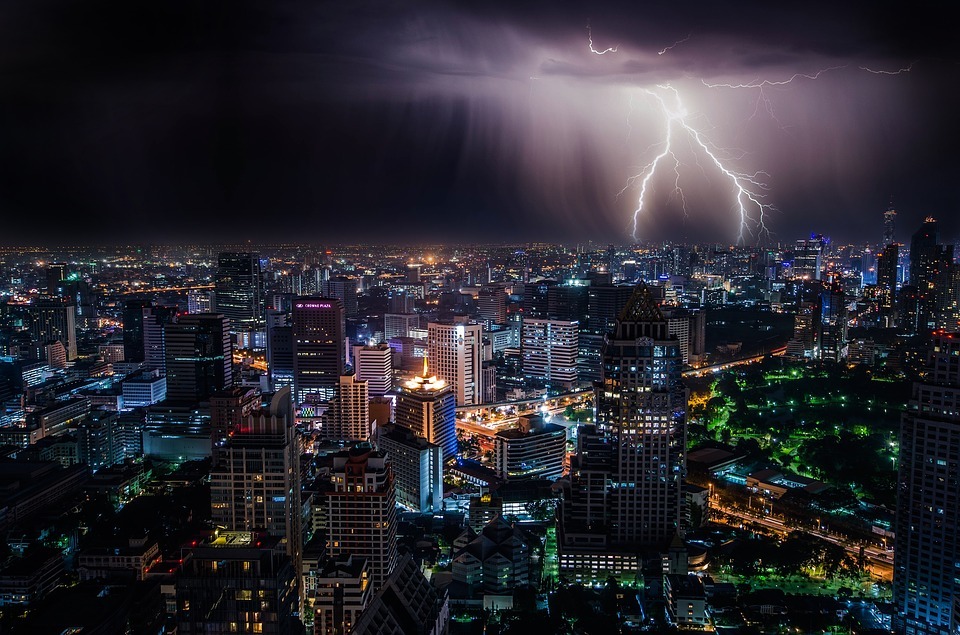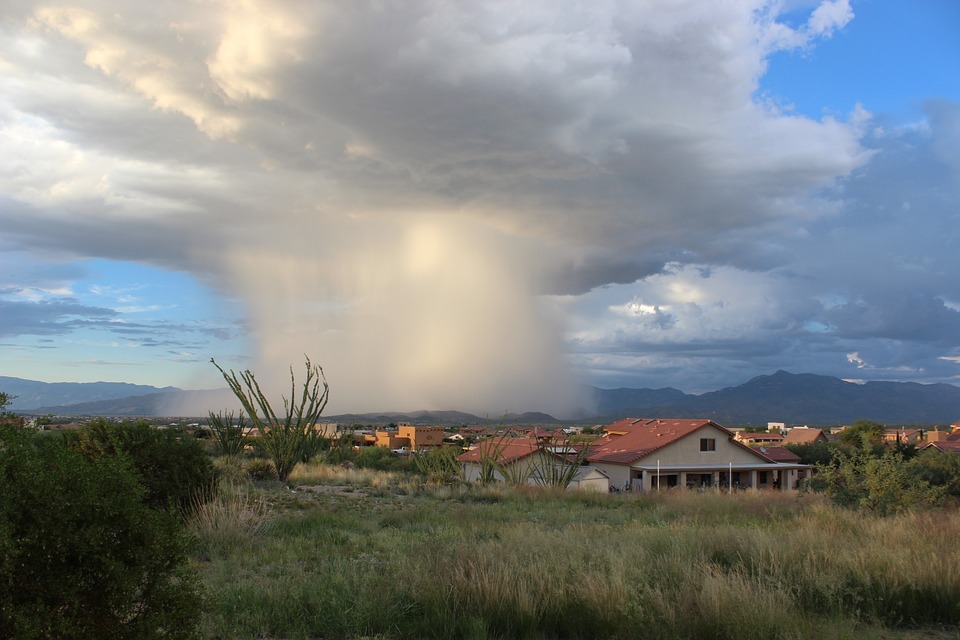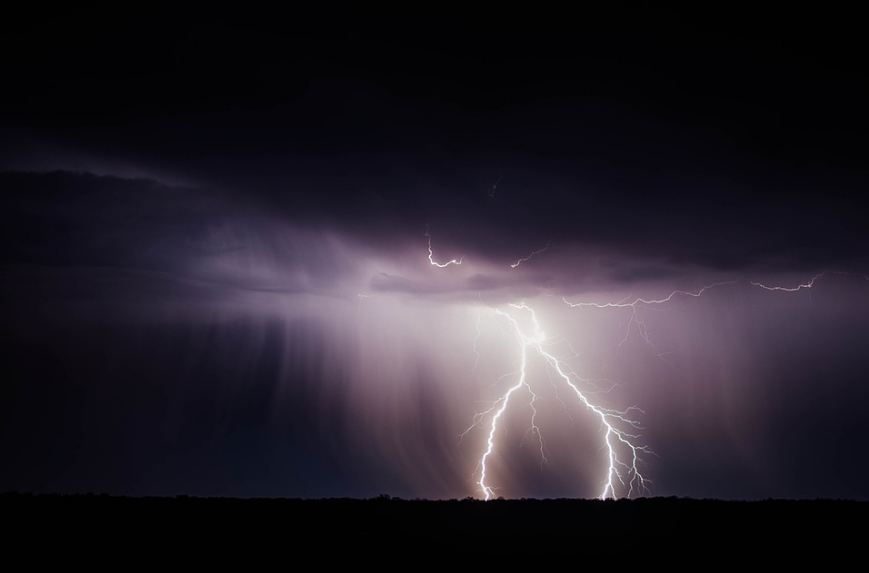What Causes Green Lightning? Unveiling the Science Behind the Rare Phenomenon
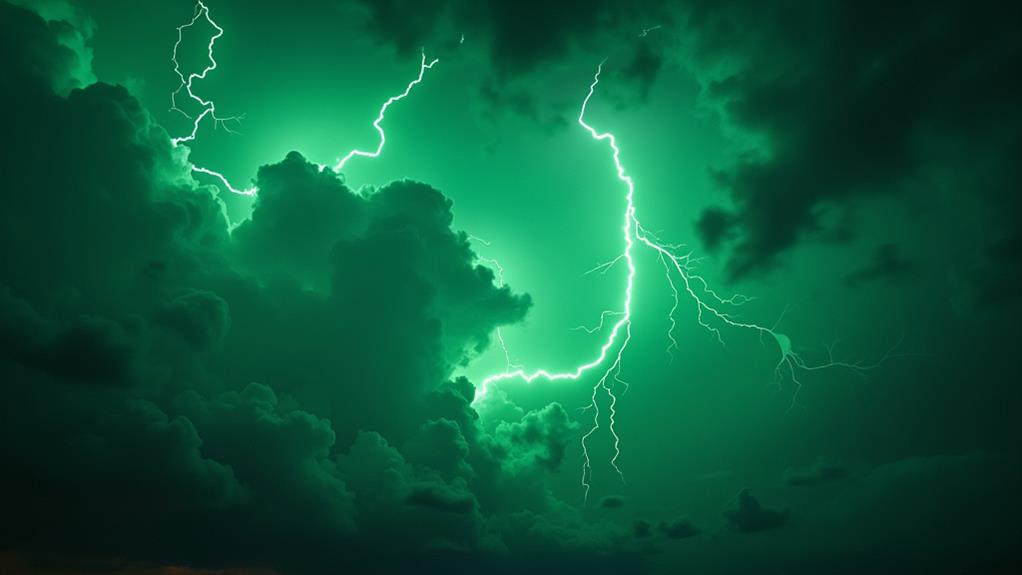
Have you ever wondered what causes green lightning to streak across the sky? This rare and captivating phenomenon transcends the typical thunderstorm, involving a complex interplay of atmospheric conditions. High humidity and ice crystals create an environment conducive to oxygen atoms emitting a green hue. Additionally, volcanic eruptions can enhance these electrical dynamics, making the green lightning more pronounced. What scientific theories and technological advances help us understand this elusive event? Stay tuned to explore the intricate science behind green lightning and its mesmerizing appearance.
Observing Green Lightning
Witnessing green lightning is a rare and captivating experience, often associated with severe weather events like thunderstorms. This atmospheric phenomenon, characterized by its distinct greenish hue, appears ethereal and almost otherworldly. Observing green lightning requires being in the right place at the right time, with favorable viewing angles and specific lighting conditions enhancing its visibility.
Green lightning has been documented during several notable events, including the Chaiten volcano eruption in May 2008, which produced stunning photographs of this elusive phenomenon. Volcanic ash clouds and unique atmospheric conditions during such eruptions contribute to the occurrence of green lightning. Similarly, this phenomenon has been observed during the Kaikoura earthquake in New Zealand and thunderstorms in places like Oklahoma City and Kansas.
Despite its rarity, green lightning sparks public intrigue and curiosity, mainly because it's much less common than the usual white or blue-white lightning seen during storms. When observing lightning storms, keep an eye out for those rare moments when green lightning might flash across the sky, offering a mesmerizing glimpse into the complexities of atmospheric phenomena. The combination of rarity and beauty makes each sighting truly unforgettable.
Formation of Lightning
To understand the formation of lightning, begin with the interaction of ice crystals and water droplets within storm clouds, which results in the separation of positive and negative charges. This dynamic process creates an electrical field strong enough to cause a rapid discharge, with negative charges descending towards the ground and attracting positive charges upward. This entire sequence of events occurs in mere millionths of a second, culminating in a lightning strike.
Electrical Charge Dynamics
Lightning's dramatic display often captures our attention, but the underlying electrical charge dynamics are equally fascinating. Within storm clouds, the interaction of positive and negative charges sets the stage for lightning. Ice crystals play an essential role by separating these charges and creating the electrical surges needed for lightning bolts to form.
Here's a breakdown of the process:
- Electrical charge: Storm clouds become electrically charged as updrafts carry lighter ice crystals upward while heavier particles fall downward.
- Charged regions: Collisions between ice crystals and other particles create positively charged regions at the top of the cloud and negatively charged areas at the bottom.
- Positive streamers: These streamers carry current from positively charged regions to negatively charged areas, facilitating the lightning discharge.
- Volcanic ash influence: During volcanic eruptions, ash in the atmosphere can enhance electrical charge dynamics, sometimes contributing to the formation of green lightning.
- Deep thunderstorm clouds: These clouds provide the necessary conditions for electrical discharges, often concealing the rare green lightning from plain sight.
Understanding these dynamics not only demystifies the formation of lightning but also reveals the intricate processes behind unique phenomena like green lightning.
Ice Crystal Interactions
The role of ice crystals within storm clouds is crucial for the formation of lightning. As these ice crystals move and collide within the cloud, they become electrically charged, leading to the separation of positive and negative charges into distinct regions. This charge separation sets the stage for lightning strikes.
| Interaction | Impact |
|---|---|
| Ice crystal movement | Charge separation within the storm cloud |
| Collisions | Transfer and buildup of electrical charges |
| Atmospheric influence | Affects visibility and lightning characteristics |
| Charged particles | Leads to unique lightning phenomena |
When positively charged ice crystals interact with negatively charged regions, they form channels known as positive streamers. These streamers are essential for the transfer of current that results in lightning strikes. The specific conditions within the storm cloud, such as temperature and humidity, further influence the characteristics of the lightning produced.
Interestingly, green lightning can occur due to these interactions. The charged ice crystals and specific atmospheric conditions can create rare and visually striking green lightning during severe weather. This phenomenon underscores the complex role ice crystals play in lightning formation. Understanding these interactions helps explain why unusual lightning events occur, adding depth to our knowledge of meteorological phenomena.
Positive and Negative Streams
Understanding the formation of lightning involves the dynamics between positive and negative charges within storm clouds. In cumulonimbus clouds, positive charges rise while negative charges sink, creating a strong potential difference that sets the stage for electrical discharges. When these discharges occur, they often result in lightning, which can sometimes appear with a green hue.
The green hue in lightning primarily results from the excitation of oxygen atoms in the atmosphere. When electric currents pass through the air, they excite oxygen atoms, which then emit light at specific wavelengths, producing the green color. Specific atmospheric conditions and the presence of ice crystals enhance this phenomenon.
Key factors include:
- Positive and negative charges: Their separation in storm clouds is crucial for lightning formation.
- Electrical discharges: These occur due to the charge separation.
- Excited oxygen: This causes the green hue in lightning.
- Ice crystals: They significantly influence charge dynamics.
- Volcanic eruptions: They can increase the likelihood of green lightning by injecting ash and particles into the atmosphere, which can affect electrical activity.
Understanding these elements provides a comprehensive view of the factors contributing to lightning and its occasional green appearance.
Atmospheric Conditions
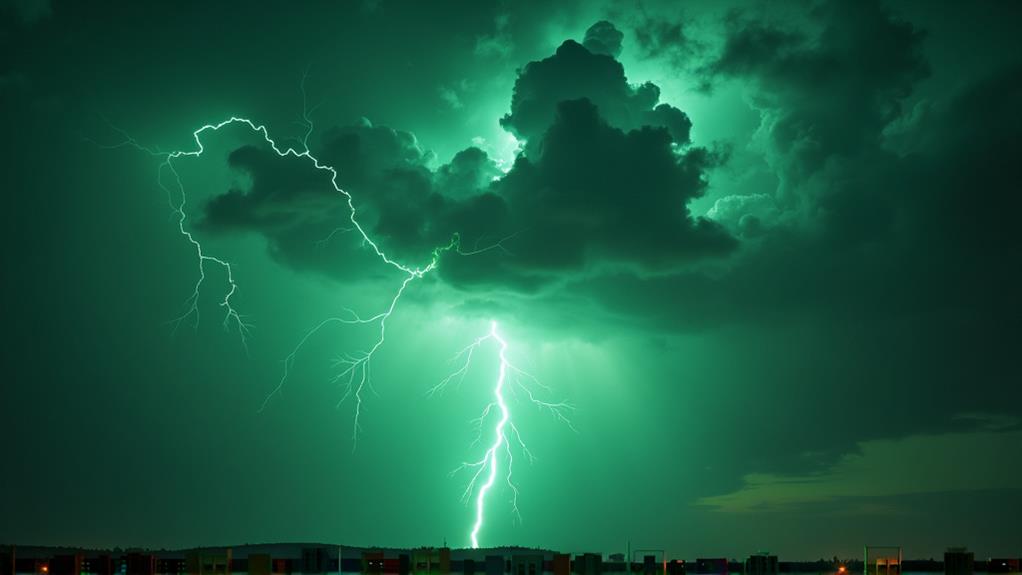
To comprehend green lightning, it is essential to consider specific atmospheric conditions. Variations in humidity and temperature, along with the presence of ice crystals, significantly affect its visibility. Additionally, your viewing angle and ambient lighting conditions can influence how you perceive this rare phenomenon.
Humidity and Temperature Variations
Imagine stepping into the heart of a thunderstorm where the air is thick with humidity and temperatures fluctuate wildly—these are the conditions that set the stage for green lightning. High humidity and temperature variations create a unique environment that enhances the visibility of the green hue during electrical discharges. When the atmosphere is saturated with moisture, it leads to more intense thunderstorms, providing the perfect backdrop for green lightning. These conditions influence the behavior of electrically charged particles within the storm clouds, and the fluctuations in temperature play a significant role in this dynamic.
Here's how humidity and temperature variations contribute to green lightning:
- High humidity: Saturated air intensifies storms, increasing the likelihood of green lightning.
- Temperature variations: Fluctuating temperatures affect the behavior of charged particles.
- Electrically charged particles: These particles are influenced by both humidity and temperature, essential for lightning formation.
- Deep storm clouds: These clouds offer the right combination of atmospheric conditions.
- Intense thunderstorms: Enhanced by humidity, they set the stage for this rare phenomenon.
Presence of Ice Crystals
While humidity and temperature variations set the stage for intense storms, the presence of ice crystals within storm clouds plays a vital role in the phenomenon of green lightning. These ice crystals are crucial in forming the electrical charges necessary for lightning. In the core of thunderstorm clouds, the combination of ice crystals and supercooled water droplets facilitates the separation of positive and negative charges. This charge separation is essential for any lightning discharge, including the rare green variety.
Atmospheric conditions, such as high humidity and significant temperature variations, contribute to the development of deep thunderstorm clouds. Within these clouds, interactions between ice crystals and other charged particles are key. These interactions can lead to the formation of positive streamers, which transfer current and produce the elusive green hue observed during some lightning strikes.
Green lightning is most commonly seen during severe weather events when the combination of ice crystals, moisture, and charged particles reaches its peak. This perfect storm of conditions creates the ideal environment for green lightning to make its dramatic appearance, turning a regular thunderstorm into a spectacular light show.
Viewing Angles and Lighting
The visibility of green lightning depends heavily on specific atmospheric conditions and viewing angles. This rare phenomenon is not always easily seen unless the environment is just right. High moisture levels in the air, combined with ice crystals in storm clouds, can enhance the color contrast, making green lightning more noticeable. The angle from which you observe it is also crucial; it often remains hidden within storm clouds and only becomes visible from certain positions.
Lighting conditions are another key factor. Nighttime offers the best opportunity to witness green lightning, as the darkness allows the distinct hue to stand out more prominently. Severe weather events, like thunderstorms or volcanic eruptions, create favorable conditions for green lightning due to the suitable cloud structures and charged particles present.
To optimize your chances of witnessing green lightning, consider the following factors:
- High moisture levels: Increase the likelihood of seeing green lightning.
- Presence of ice crystals: Enhances color contrast within storm clouds.
- Observation angle: Crucial for spotting green lightning.
- Nighttime visibility: Provides the best lighting conditions.
- Severe weather events: Create ideal atmospheric conditions.
Understanding these elements can greatly improve your chances of witnessing the elusive green lightning.
Chemical Reactions
Chemical reactions are crucial in the formation of green lightning. When lightning strikes, it excites oxygen atoms in the atmosphere, causing them to emit light at specific wavelengths, notably 528.0 nm and 583.5 nm. This emission results in the distinctive green color. The interaction between ionized particles and oxygen atoms is fundamental to this process. Atmospheric conditions such as humidity and the presence of ice crystals significantly affect the visibility and intensity of the green lightning.
Volcanic eruptions can also contribute to green lightning. Volcanic ash clouds, laden with minerals, create external electrical charges that interact with the atmosphere. These interactions can excite oxygen atoms, producing green lightning during eruptions. The combination of charged particles and specific atmospheric conditions during these events increases the likelihood of green lightning.
Laboratory experiments have been instrumental in understanding these chemical reactions. By simulating electrical discharges with various gases, scientists have elucidated the mechanisms behind green lightning. These studies reveal how ionized particles and atmospheric conditions converge to create this rare and captivating phenomenon.
Historical Sightings
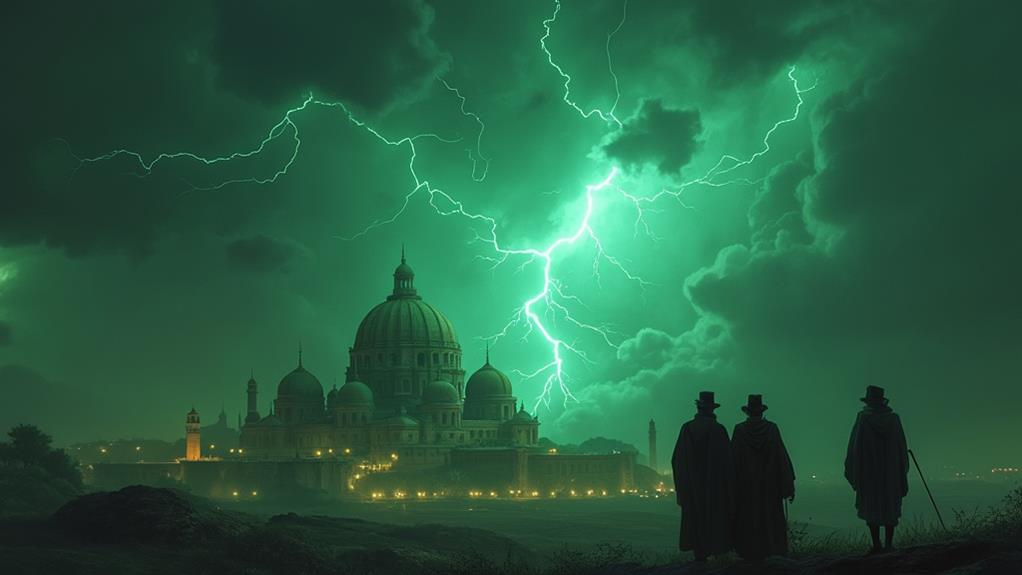
Historical sightings of green lightning, although rare, have been documented during some of the most dramatic natural events. One notable instance occurred during the Chaiten volcano eruption in May 2008, where the volcanic ash created conditions conducive to this unusual phenomenon. Green lightning has also been reported during significant weather events such as the Kaikoura earthquake (M7.8) in New Zealand and thunderstorms in Oklahoma City. These sightings emphasize the importance of specific atmospheric conditions in making this elusive lightning visible.
Key historical sightings include:
- Chaiten Volcano Eruption (2008): Volcanic ash and unique atmospheric conditions enhanced the visibility of green lightning.
- Kaikoura Earthquake (New Zealand): Witnesses reported green lightning during this significant seismic event.
- Thunderstorms in Oklahoma City: Documented sightings add to the phenomenon's mystique.
- Kansas: Instances of green lightning have occasionally occurred, often missed due to its rarity.
- South Africa: Reports from this region highlight the sporadic and global nature of green lightning sightings.
The rarity and specific atmospheric conditions required for green lightning often result in missed sightings. However, personal accounts and historical documentation confirm its occurrence during severe weather events, adding to its allure.
Scientific Theories
Historical sightings of green lightning provide a foundation for understanding the scientific theories behind this rare phenomenon. One prominent theory suggests that green lightning occurs due to the excitation of oxygen atoms in the atmosphere. When these atoms are electrically charged during lightning strikes, they emit a green hue. Specific atmospheric conditions, such as the presence of ice crystals and high moisture content, can enhance the visibility of this green coloration.
Another theory involves positive streamers, which transfer current between charged regions in storm clouds. This electrical discharge may produce the distinct green color. However, spectral analysis has revealed that iron, rather than oxygen, plays a significant role in certain atmospheric events. This includes the green ghost phenomenon associated with sprites, adding complexity to the understanding of green lightning.
Ongoing research aims to clarify these mechanisms and interactions, as green lightning remains less understood compared to other types of lightning. These scientific theories are crucial for deepening our understanding and may eventually lead to groundbreaking revelations in atmospheric science.
Technological Advances
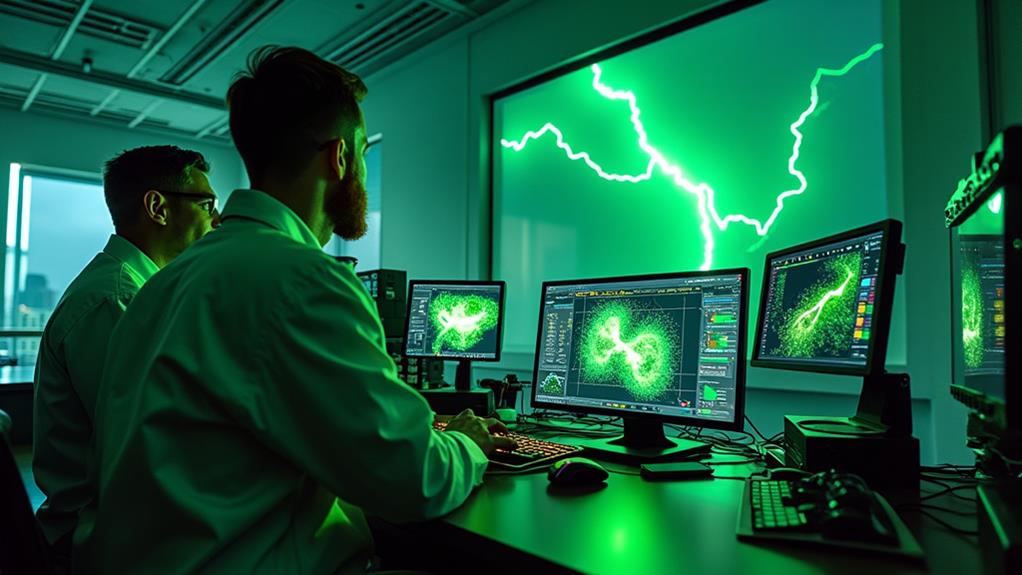
Recent technological advances have significantly enhanced our ability to study green lightning and other transient luminous events (TLEs). These innovations allow for deeper exploration of the fascinating phenomena that illuminate our skies. High-speed cameras and low-light imaging techniques have revolutionized the capture of rare occurrences like green lightning in unprecedented detail.
- High-speed cameras document the rapid and fleeting moments of green lightning.
- Spectral analysis techniques identify specific wavelengths emitted, correlating them to atmospheric gases like iron and oxygen.
- Radar technology improves understanding of storm cloud behavior, crucial for developing accurate meteorological models.
- Collaborative efforts with international teams have expanded observational capabilities, utilizing advanced equipment like aircraft and ground-based sensors.
- Low-light imaging techniques capture TLEs even in the darkest skies, enhancing data detail and clarity.
These technological advances not only facilitate the capture of green lightning but also provide essential tools for its analysis and understanding. By integrating these technologies, researchers gain a comprehensive view of how and why these spectacular events occur, laying the groundwork for further scientific exploration.
Future Research
Future research aims to further elucidate the atmospheric mechanisms responsible for the distinctive green hue of lightning. Scientists are particularly focused on the interactions between oxygen and nitrogen molecules during storms that result in this unique coloration. By employing advanced imaging techniques and conducting laboratory experiments, researchers hope to identify the precise conditions that make green lightning visible within storm clouds.
Additionally, there is increasing interest in exploring the connections between green lightning and other transient luminous events (TLEs). These studies could provide new insights into atmospheric chemistry and electrical activity, thereby deepening our understanding of these phenomena. Collaborative efforts among scientists are also in progress to develop better observational tools and meteorological models. These tools aim to detect hidden lightning occurrences within thunderstorms, offering a more comprehensive view of severe weather events.
Continued examination of green lightning's characteristics and origins promises significant advancements in meteorological models. This could eventually lead to improved safety measures during severe weather events, enhancing community preparedness and response to lightning-related dangers. As research advances, the enigmatic nature of green lightning will become increasingly clear.

